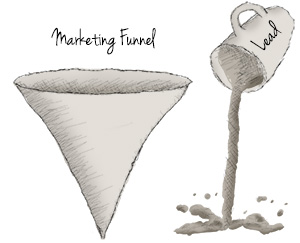Marketing automation and lifecycle marketing. How do they fit together? Why should you be using them for your business?
In the general sense, marketing automation is defined as automating manual tasks associated with the marketing function. However, most people associate marketing automation with the process of delivering “sales ready leads” to the sales team.
If you look at the vendors in the space, they loosely define marketing automation as scoring and nurturing leads before they get passed to the sales team. They stop at the point where a prospect becomes a customer. For the concept of the marketing funnel to work, all of the nurtured, ideal fit advocates at the bottom had to have come in to the top of the funnel to begin with – meaning, sourced from marketing. However, most business that closes is not “sourced” from marketing – but; is, rather, “influenced” by marketing. Ask any enterprising entrepreneur where their first ten customers came from; I assure you they would not say marketing leads. They would say they came from existing relationships.
 It’s often been said that it’s easier and less expensive to retain or upsell a customer than bring on a new one. But, companies continue to allocate the majority of their marketing spend on generating more leads. If I were a VP of Marketing, and I received bonuses based on the number of leads I generate, which turn into sales – then, of course, I would focus 100% of my attention on driving more leads and convincing the sales team that they needed to chase and close them. The million-dollar question is: how much (percentage and actual revenue) can you truly show was sourced from marketing? The reports that I have read say 25% is a very high percentage even for best in class B2B companies.
It’s often been said that it’s easier and less expensive to retain or upsell a customer than bring on a new one. But, companies continue to allocate the majority of their marketing spend on generating more leads. If I were a VP of Marketing, and I received bonuses based on the number of leads I generate, which turn into sales – then, of course, I would focus 100% of my attention on driving more leads and convincing the sales team that they needed to chase and close them. The million-dollar question is: how much (percentage and actual revenue) can you truly show was sourced from marketing? The reports that I have read say 25% is a very high percentage even for best in class B2B companies.
Or, let’s look at it from the VP of Sales standpoint. You have a field-based sales team with ten reps. In each territory, you identify 20 ideal targets.
Option A: Wait for marketing to put one of these folks in the funnel, qualify them and then pass to the sales team. “Hey! I’m still out here waiting for marketing to pass me one of my targets!” or,
Option B: You drive your sales team to engage with each of the 20 targets through their efforts and networks. They will never go in the marketing funnel – they will go in the sales funnel/pipeline.
Customer Lifecycle Marketing is about tracking, scoring, and engaging all customers and prospects based on where they are in their relationship with the brand. It challenges the concept that all business is generated from marketing and all leads flow through a marketing funnel before the sales team (or others in the organization) engages them. It is a paradigm shift that places a much more important emphasis on the marketing function (not just about generating leads and passing them to the sales team). It’s about understanding the business – who your best customers are and driving engagement throughout the customer experience. Happy, satisfied, loyal customers will drive more ideal leads for an organization than the old school, “fill the funnel with leads” approach. 
Suppose I am a sales guy. I get introduced to you via a mutual friend. We have coffee and I learn more about your challenges and goals. I present a solution to your problem – you buy and become a customer. Where does this relationship get put in the “marketing funnel?” It doesn’t. And, marketing is not getting any credit for helping, because they are being measured on the number of leads and of those, which ones become customers.
Customer Lifecycle Marketing is different way of looking at your business – across all stages of the customer experience. Marketing plays the critical role of ensuring the right programs and campaigns (sales, marketing, and client success) are all working together to drive engagement with the best prospects and customers to move them forward in the relationship, regardless of their stage. Our solution is truly the only one that provides organizations visibility to where all of their customers and prospects are in the relationship (or customer journey). From suspect to loyal customer, you see them all and use automation to drive further engagement.
Relationships come before revenue in the dictionary and in business. Drive the relationships and you will earn the revenue.

